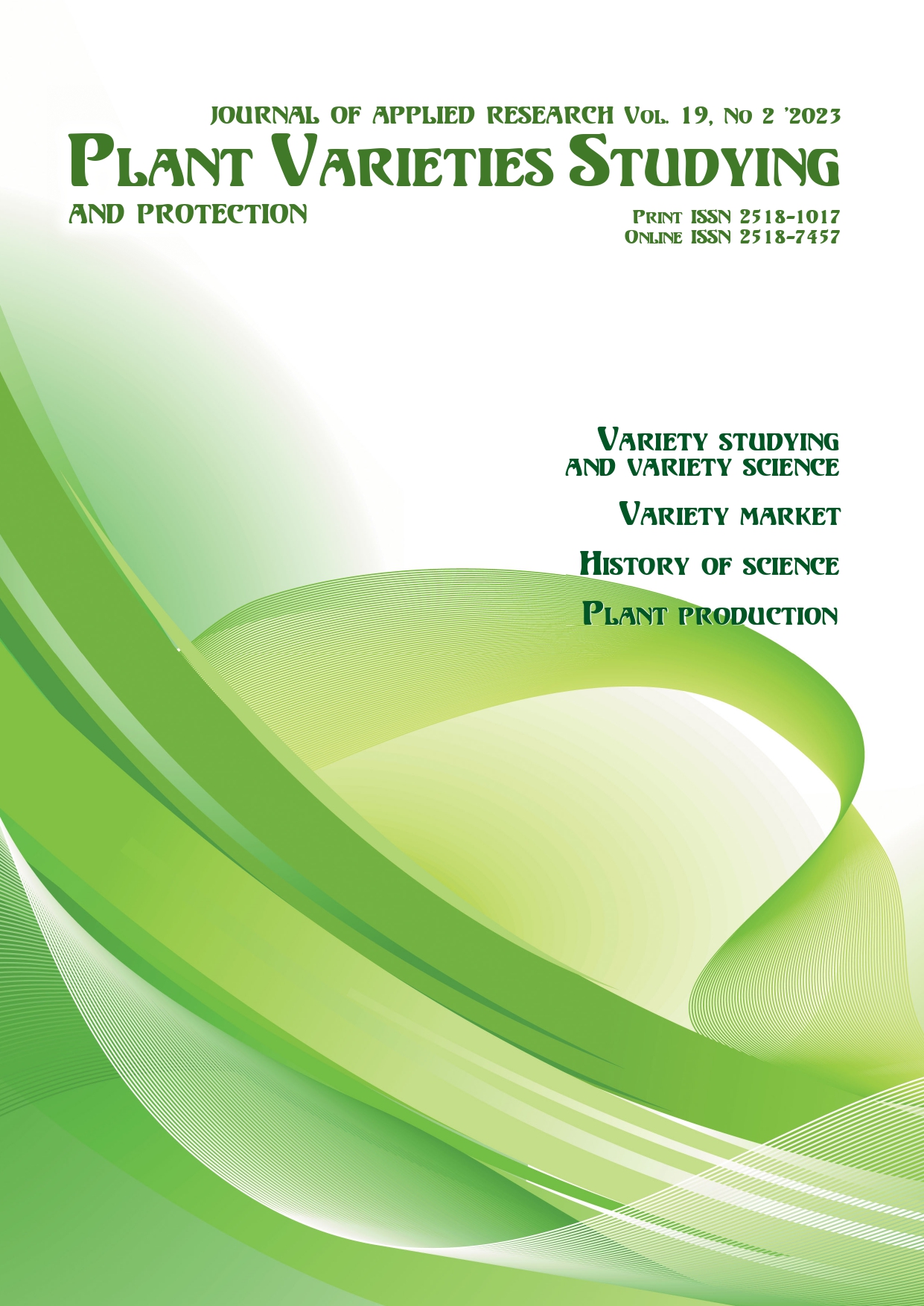Comprehensive evaluation of morphological and economically valuable traits of common buckwheat (Fagopyrum esculentum Moench) varieties
DOI:
https://doi.org/10.21498/2518-1017.19.2.2023.282549Keywords:
identification, suitability indicators, sign, breeding, phenotype, grain, phenological phases, productivity, qualityAbstract
Purpose. To carry out a comprehensive evaluation of the morphological and economically valuable characteristics of common buckwheat (Fagopyrum esculentum Moench) varieties.
Methods. Common buckwheat varieties of the State University of Agriculture and Engineering in Podillia were studied. The analysis of their quantitative, qualitative and pseudo-qualitative characteristics and economically valuable traits was carried out in accordance with “Methods of examination of plant varieties of the group of cereals, grains and legumes for suitability for distribution in Ukraine” and “Methodology of examination of varieties of common buckwheat (Fagopyrum esculentum Moench) for distinctness, uniformity and stability. Methodology for the examination of plant varieties of the legume and cereal groups for distinctness, uniformity and stability”. Field trials were carried out in 2021–2022 on the experimental field of the Scientific Research Center “Podillia” of the State University of Agriculture and Engineering in Podillia. Research methods: field, laboratory, statistical and analytical. In order to identify plant varieties, a morphological description of their vegetative and generative organs was carried out (method of visual assessment of phenotype).
Results. Common buckwheat varieties of domestic breeding were identified by morphological characteristics. For the field inspection of its seed crops, the morphological code formula of the variety was established and published in the official publication.
Conclusions. Obtaining valuable, highly productive biotypes, as well as competitive varieties recommended for production and used in breeding practice, which replenish the fund of national plant resources, is possible thanks to their comprehensive evaluation at all stages of the breeding process. The table for the identification of candidate varieties of common buckwheat has been improved in the part of the list of morphological characteristics, the developed code formulas of which have practical application in the field inspection of seed crops.
Downloads
References
Matejčekovaˆ, Z., Liptaˆkovaˆ , D., & Valiˆk Ľ. (2017). Functional probiotic products based on fermented buckwheat with Lactobacillus rhamnosus. LWT - Food Science and Technology, 81, 35–41. doi: 10.1016/j.lwt.2017.03.018

Mackėla, I., Andriekus, T., & Venskutonis, P. R. (2017). Biorefining of buckwheat (Fagopyrum esculentum) hulls by using supercritical fluid, Soxhlet, pressurized liquid and enzyme-assisted extraction methods. Journal of Food Engineering, 213, 38–46. doi: 10.1016/j.jfoodeng.2017.04.029

Obidzinˆski S., Piekut J., & Dec D. (2016). The influence of potato pulp content on the properties of pellets from buckwheat hulls. Renewable Energy, 87, 289–297. doi: 10.1016/j.renene.2015.10.025

Hęś, M., Szwengiel, A., Dziedzic, K., Le Thanh-Blicharz, J., Kmiecik, D., & Goˆrecka, D. (2017). The effect of buckwheat hull extract on lipid oxidation in frozen-stored meat products. Journal of Food Science, 82(4), 882–889. doi: 10.1111/1750-3841.13682
 |
| 
Vaickelionis, G., & Valančienė, V. (2016). Lightweight concrete with an agricultural waste–buckwheat husk. Materials Science, 22(1), 98–104. doi: 10.5755/j01.ms.22.1.8662
Tryhub, O., Burdyga, V., Kharchenko, Y., & Havrylyanchyk, R. (2018). Formation of buckwheat genepool collection in Ukraine and directions of its usage. Fagopyrum, 35(1), 29–36. doi: 10.3986/fag0005
Mukasa, Y. (2011). Studies on new breeding methodologies and variety developments of two buckwheat species (Fagopyrum esculentum Moench. and F. tataricum Gaertn.). Research bulletin of the NARO Hokkaido Agricultural Research Center, 195, 57–114. Retrieved from https://www.naro.go.jp/publicity_report/publication/files/195-04en.pdf
Fesenko, A. N., Fesenko, I. N., & Ohnishi, O. (1998). Some genetic peculiarities of reproductive system of wild relatives of common buckwheat Fagopyrum esculentum. In Proceedings of 7th International Symposium on Buckwheat (Part. 6. pp. 32–35). Winnipeg, MB, Canada: IBRA.
Woo, S. H., Roy, S. K., Kwon, J. S., Cho, S. W., & Kim, H. H. (2018). Interspecific crosses between Fagopyrum cymosum and other species through embryo culture techniques. In M. Zhou, I. Kreft, G. Suvorova, Y. Tang, & S.-H. Woo (Eds.), Buckwheat Germplasm in the World (pp. 249–258). London, UK: Academic Press. doi: 10.1016/B978-0-12-811006-5.00024-0
Krawczyk, R., & Mroˆwczynˆski, M. (2017). Metodyka integrowanej ochrony gryki dla doradcoˆw. Poznan: N. p. Retrieved from https://www.ior.poznan.pl/plik,3191,metodyka-integrowanej-ochrony-gryki-dla-doradcow-pdf.pdf
Vilchynska, L. A., Horodyska, O. P., & Diyanchuk, M. V. (2020). Buckwheat selection for resistance to extreme environmental factors. Factors in Experimental Evolution of Organisms, 27, 55–60. doi: 10.7124/FEEO.V27.1302
Methodology for examination of varieties of edible buckwheat (Fagopyrum esculentum Moench) for distinction, homogeneity and stability. (2016). In S. O. Tkachyk (Ed.), Metodyka provedennia ekspertyzy sortiv roslyn hrupy zernobobovykh ta krupianykh na vidminnist, odnoridnist i stabilnist [The method of examination of plant varieties of the leguminous and cereal groups for distinction, uniformity and stability] (2nd ed., rev. аnd enl., pp. 129–140). Vinnytsia: FOP Korzun D. Yu., 2016. Retrieved from https://sops.gov.ua/uploads/page/5b9233c047623.pdf [In Ukrainian]
Test Guidelines for the conduct of tests for distinctness, uniformity and stability of Buckwheat (Fagopyrum esculentum Moench) (TG /278/1, UPOV). (2012). Geneva: UPOV. Retrieved from https://www.upov.int/edocs/tgdocs/en/tg278.pdf
Tkachyk, S. O. (2014). Metodyka provedennia ekspertyzy sortiv roslyn hrupy zernovykh, krupianykh ta zernobobovykh na prydatnist do poshyrennia v Ukraini [Methodology for examination of plant varieties of the cereal, grain and leguminous groups for suitability for distribution in Ukraine]. Kyiv: Nilan-LTD. Retrieved from https://sops.gov.ua/uploads/page/5a5f4147d3595.pdf [In Ukrainian]
Ministry of Agrarian Policy and Food of Ukraine. (2023). State register of plant varieties suitable for distribution in Ukraine for 2023. Kyiv: Ministry of Agrarian Policy and Food of Ukraine. Retrieved from https://sops.gov.ua/reestr-sortiv-roslin [In Ukrainian]
Downloads
Published
How to Cite
Issue
Section
License
Copyright (c) 2023 L. A. Vilchynska, N. V. Leshchuk, O. V. Nochvina, O. V. Svynarchuk, A. I. Sydorchuk, N. V. Kurochka

This work is licensed under a Creative Commons Attribution-ShareAlike 4.0 International License.
Starting in 2022, the copyright to the publication remains with the authors
Our journal abides by the CREATIVE COMMONS copyright rights and permissions for open access journals.
Authors, who are published in this journal, agree to the following conditions:
- The authors reserve the right to authorship of the work and pass the first publication right of this work to the journal under the terms of a Creative Commons Attribution License, which allows others to freely distribute the published research with the obligatory reference to the authors of the original work and the first publication of the work in this journal.
- The authors have the right to conclude separate supplement agreements that relate to non-exclusive work distribution in the form in which it has been published by the journal (for example, to upload the work to the online storage of the journal or publish it as part of a monograph), provided that the reference to the first publication of the work in this journal is included.

























 Ukrainian Institute for Plant Varieties Examination
Ukrainian Institute for Plant Varieties Examination  Селекційно-генетичний інститут
Селекційно-генетичний інститут Institute of Plant Physiology and Genetics of the National Academy of Sciences of Ukraine
Institute of Plant Physiology and Genetics of the National Academy of Sciences of Ukraine
 The National Academy of Agrarian Sciences of Ukraine
The National Academy of Agrarian Sciences of Ukraine